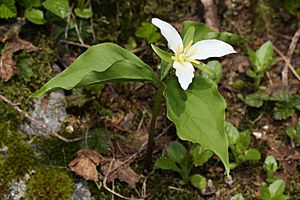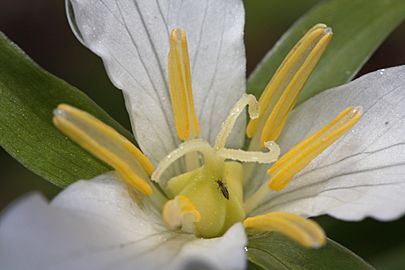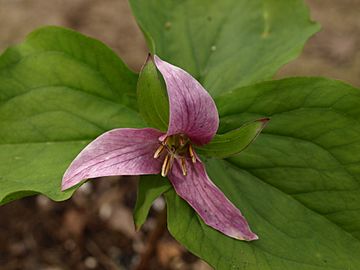Western wakerobin facts for kids
Quick facts for kids Western wakerobin |
|
|---|---|
 |
|
| Trillium ovatum in Mount Baker-Snoqualmie National Forest | |
| Conservation status | |
| Scientific classification | |
| Genus: |
Trillium
|
| Species: |
ovatum
|
| Synonyms | |
|
Synonymy
Trillium californicum Kellogg
Trillium crassifolium Piper Trillium obovatum Hook., nom. illeg. Trillium ovatum var. hibbersonii (T.M.C.Taylor & Szczaw.) G.W.Douglas & Pojar Trillium ovatum f. maculosum Case & R.B.Case Trillium ovatum subsp. oettingeri Munz & Thorne Trillium ovatum var. stenosepalum R.R.Gates Trillium venosum R.R.Gates |
|
The Pacific trillium (Trillium ovatum) is a beautiful flowering plant found in western North America. It's also known by other names like western wakerobin or western white trillium. You can find it from southern British Columbia down to central California, and east to Idaho and western Montana. There's even a small group of them far away in northern Colorado and southern Wyoming.
This plant is the most common type of trillium in western North America. It's special because it's the only Trillium species in its area that has flowers on a small stalk (called a pedicel). The first time scientists officially recorded this plant was in 1806. It was found by Meriwether Lewis near the Columbia River during the famous Lewis and Clark Expedition.
Contents
Types of Pacific Trillium
There are a few different types, or forms, of the Pacific trillium. These are like different versions of the same plant.
Dwarf Trillium
One interesting type is called Trillium ovatum f. hibbersonii, often known as the dwarf trillium. This tiny plant is only about 3 to 10 cm (1 to 4 in) tall! Unlike the regular Pacific trillium, its flowers start out pink and then turn white as they get older. You'll mostly find the dwarf trillium on Vancouver Island in British Columbia, but it can pop up in other places where the Pacific trillium grows.
Salmon Mountains Wakerobin
Another type is Trillium ovatum var. oettingeri, which is called the Salmon Mountains wakerobin. This plant is only found in the Salmon Mountains of northwestern California. Its leaves are a bit different from the usual Pacific trillium, and its flower petals are long and thin.
Some Pacific trilliums can even have spotted leaves! This is very rare for this type of trillium.
What the Pacific Trillium Looks Like
The Pacific trillium can look a bit different depending on where it grows. But it looks a lot like another trillium called Trillium grandiflorum, which grows in eastern North America. It can be hard to tell them apart just by looking, unless you know where they came from.
This plant is a perennial herbaceous plant. This means it lives for many years and its stems are soft, not woody. It spreads using underground stems called rhizomes. When it's fully grown, each plant usually has one or two flowering stems, which are about 20 to 50 cm (8 to 19.5 in) long.
The name "ovatum" means "egg-shaped." This refers to the shape of its petals, not its leaves. The leaves are usually shaped like an oval or diamond, about 7 to 12 cm (3 to 5 in) long and 5 to 20 cm (2 to 8 in) wide.
The flower sits on a small stalk (a pedicel) that is about 2 to 6 cm (1 to 2.5 in) long. The sepals (the leaf-like parts that protect the bud) are 15 to 50 mm (0.59 to 1.97 in) long. The petals are 15 to 70 mm (0.59 to 2.76 in) long. Usually, the flowers open white and then turn pink as they get older. But in some areas, like northern California and southern Oregon, the petals can even turn a deep red color!
Habitat and Life Cycle
The Pacific trillium likes to grow in forests with conifer trees (like pine and fir) and mixed forests that also have trees that lose their leaves. You can often find it near alder bushes and other shrubs. Along the California coast, it commonly grows under coast redwood trees. In places like Lolo Pass, Montana, it grows under spruce and Douglas fir trees in valleys near mountain streams.
When Do They Bloom?
These flowers start to bloom in late February in the warmer southern parts of their range. In other areas, they bloom in March or April. Many people who observe plants (called citizen scientists) report seeing the most flowers during the first week of April. The Pacific trillium finishes blooming earlier than the Trillium grandiflorum in eastern North America. It seems the Pacific trillium can't handle the cold winters east of the continental divide.
Life Cycle Stages
The Pacific trillium goes through several stages in its life:
- Cotyledon stage: This is when the plant first sprouts from a seed.
- One-leaf stage: The plant has just one leaf.
- Three-leaf juvenile stage: The plant has three leaves but isn't ready to flower yet.
- Three-leaf flowering stage: The plant has three leaves and produces flowers.
- Three-leaf nonflowering regressive stage: Sometimes, a plant that used to flower will go back to a stage where it has three leaves but doesn't flower. About one out of every four flowering plants will do this each year.
Sometimes, these plants can even go into a "sleep" mode called dormancy. This means they stop growing above ground for one or more years. In western Montana, scientists saw that adult plants would sometimes go dormant. Most of them would start growing above ground again in a year or two, but some stayed dormant for 3 to 5 years!
See also
 In Spanish: Trillium ovatum para niños
In Spanish: Trillium ovatum para niños




